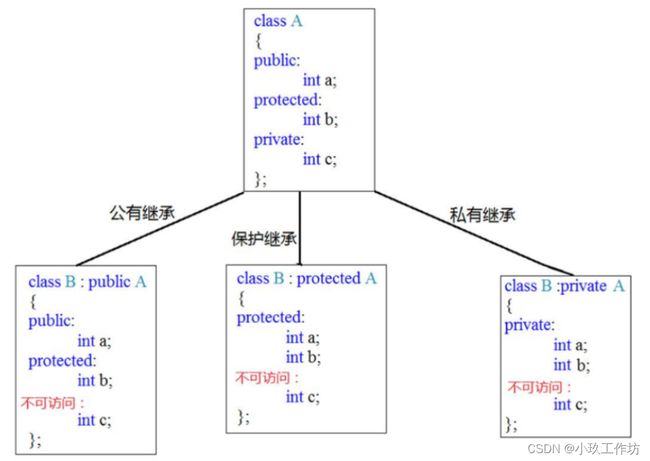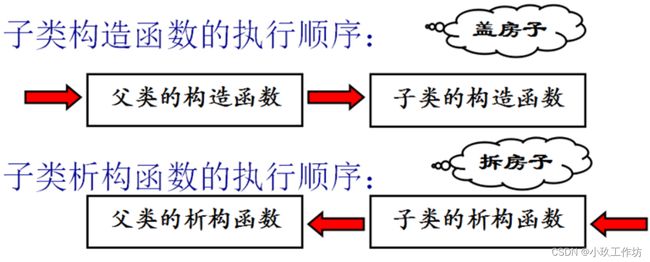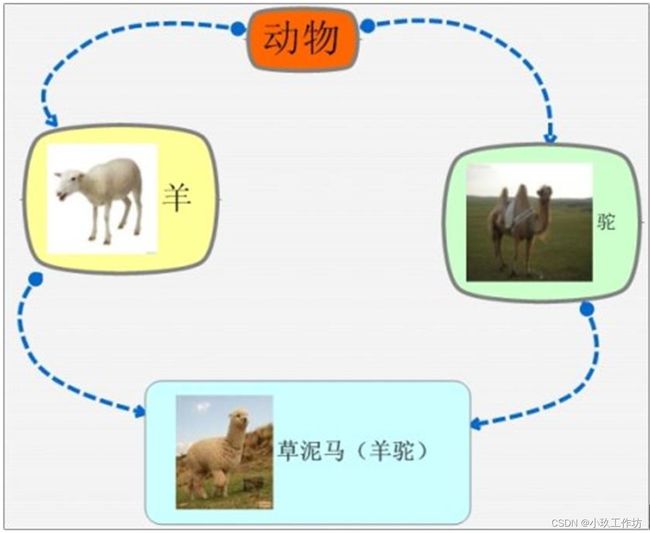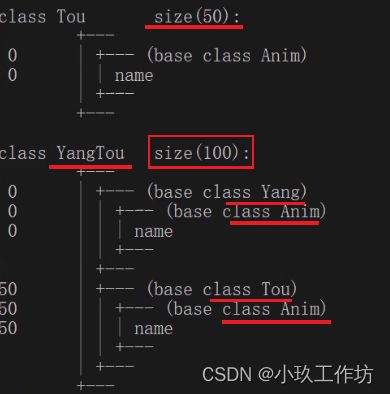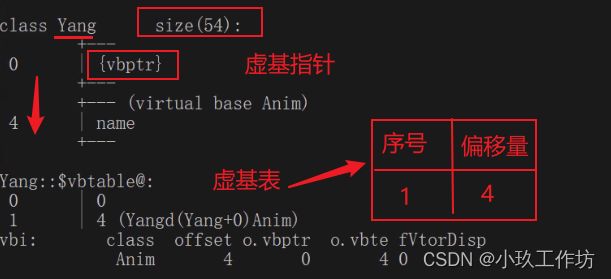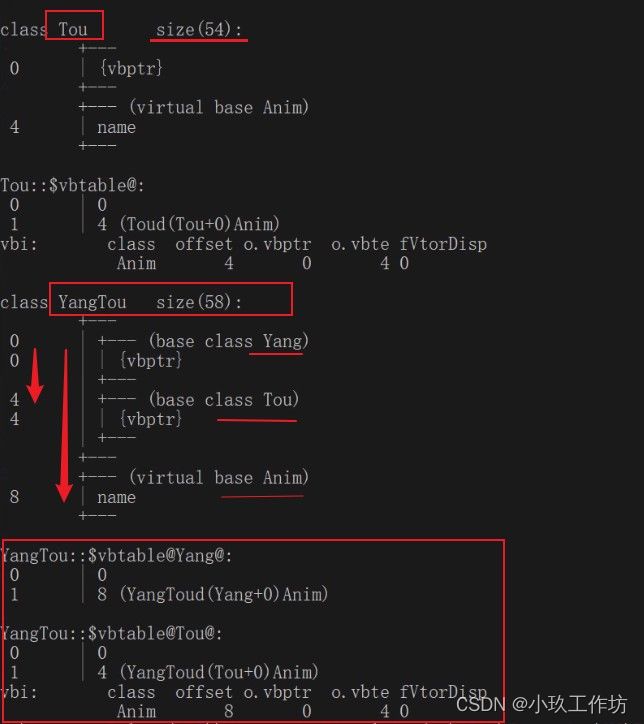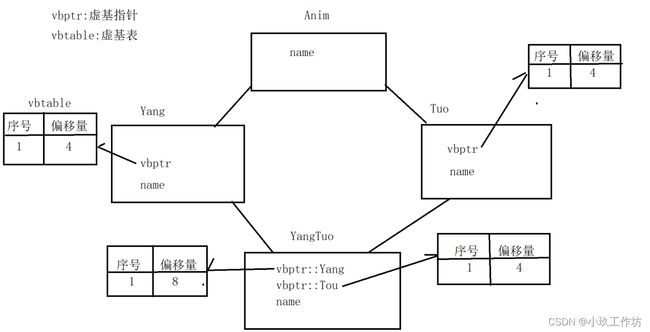05-C++ 类和对象-继承
类与对象-03
继承与派生
1. 继承的概念
c++最重要的特征是代码重用,通过继承机制可以利用已有的数据类型,来定义新的数据类型,新的类不仅拥有旧类的成员,还拥有新定义的成员。
一个 B 类继承于 A 类,或称从类 A 派生类 B。这样的话,类 A 成为基类(父类),类 B 成为派生类(子类)。
派生类中的成员,包含两大部分:
- 一类是从基类继承过来的,
- 一类是自己增加的成员。
从基类继承过过来的表现其共性,而新增的成员体现了其个性。
2. 继承的优点
1)减少重复的代码,减轻程序整体的体量。
2)继承的好处,可以将共性的内容封装成一个基类(父类),遇到专项业务时,可以扩展基类变为一个新类,在新类中重点扩展功能。
3. 继承的语法
class 子类:继承方式 父类名
{
子类新增自己的数据和方法;
};
4. 继承方式
public(推荐):子类将 原封不动的继 承父类成员,但是 不能直接访问 父类 私有的成员
protected:子类将继承到父类的成员转换为 protected修饰的成员,但是 不能直接访问 父类 私有的成员
private:子类将继承到的所有父类成员转换为 私有的成员,但是 不能直接访问 父类 私有的成员
示例1:public
#include 示例2:protected ,若是protected继承,父类中的public将变为 protected,只能在当前类或子类中使用。
#include 5. 注意
- 子类可以继承父类所有成员,但是父类私有成员不可访问
- 子类 不能继承父类 的
构造函数、拷贝构造、析构函数,但是子类中可以调用- 子类可以
多继承- 子类在
创建对象时会 调用父类构造函数,如果没有明确写出调用的父类构造函数,默认调用父类无参构造,此时如果父类没有无参构造,程序报错- 子类调用父类构造函数,在 子类构造函数后使用初始化列表方式调用父类构造函数
- operator=不能被继承
示例:
#include 6. 构造与析构的执行顺序
继承中的构造和析构:
- 子类对象在创建时会首先调用父类的构造函数
- 父类构造函数执行完毕后,才会调用子类的构造函数
- 当父类构造函数有参数时,需要在子类初始化列表(参数列表)中显示调用父类构造函数
- 析构函数调用顺序和构造函数相反
示例1:子类继承父类
#include 示例2:子类继承父类,该子类中还要其他类的成员
#include 7. 继承中父子类成员重名
7.1 成员变量重名
调用方式:
- 操作
子类成员变量:子类对象.成员变量名- 操作
父类提供的成员变量:子类对象.父类名::成员变量名
示例:
#include 7.2 成员函数重名
概念:
子类成员函数名与父类成员函数名重名,此时 子类该函数就是对父类名为该函数名的函数进行 重定义。- 重定义
- 继承关系中
- 子类函数名与父类函数名相同
- 特点:屏蔽父类该函数
调用方式:
- 操作
子类成员函数:子类对象.成员函数名(实参列表)- 操作
父类提供的成员函数:子类对象.父类名::成员函数名(实参列表)
示例:
#include 8. 多继承
概念:一个子类继承与 多个父类
语法:
class 子类名:继承方式1 父类1, 继承方式2 父类2, ...
{
子类特有成员
}
父类构造顺序:
- 子类对象创建时,按继承 编写的顺序 依次执行父类对象构造,与子类构造函数后初始化列表中的顺序无关
示例1:
#include 示例2:
#include 9. 菱形继承(了解)
概念:
A的子类A1与A2
B类多继承A1与A2类
此时这种关系称为菱形继承
注意:
- 菱形继承会导致子类用于多份祖先数据,当孙子类调用成员(函数或数据)时,会产生二义性。
- 如:
- A类中提供num成员变量
- A1与A2类属于A的子类,,那么A1与A2类将各自拥有一份num
- B作为A1与A2的子类,那么
B将拥有两个num
示例:
#include 菱形继承类布局:
10. 虚继承
概念:使用 virtual修饰继承关系
语法:
class 子类名:virtual 继承关系 父类名
{
};
解决问题:
解决菱形继承的调用二义性,多个类只保存一份相同数据
如:
- A类中提供num成员变量
- A1与A2类属于A的子类,那么A1与A2类将各自拥有一份num
- B作为A1与A2的子类,那么B将拥有两个num,此时调用num会出现二义性
- 所以只能虚继承使其存储一个num.
示例:
#include 